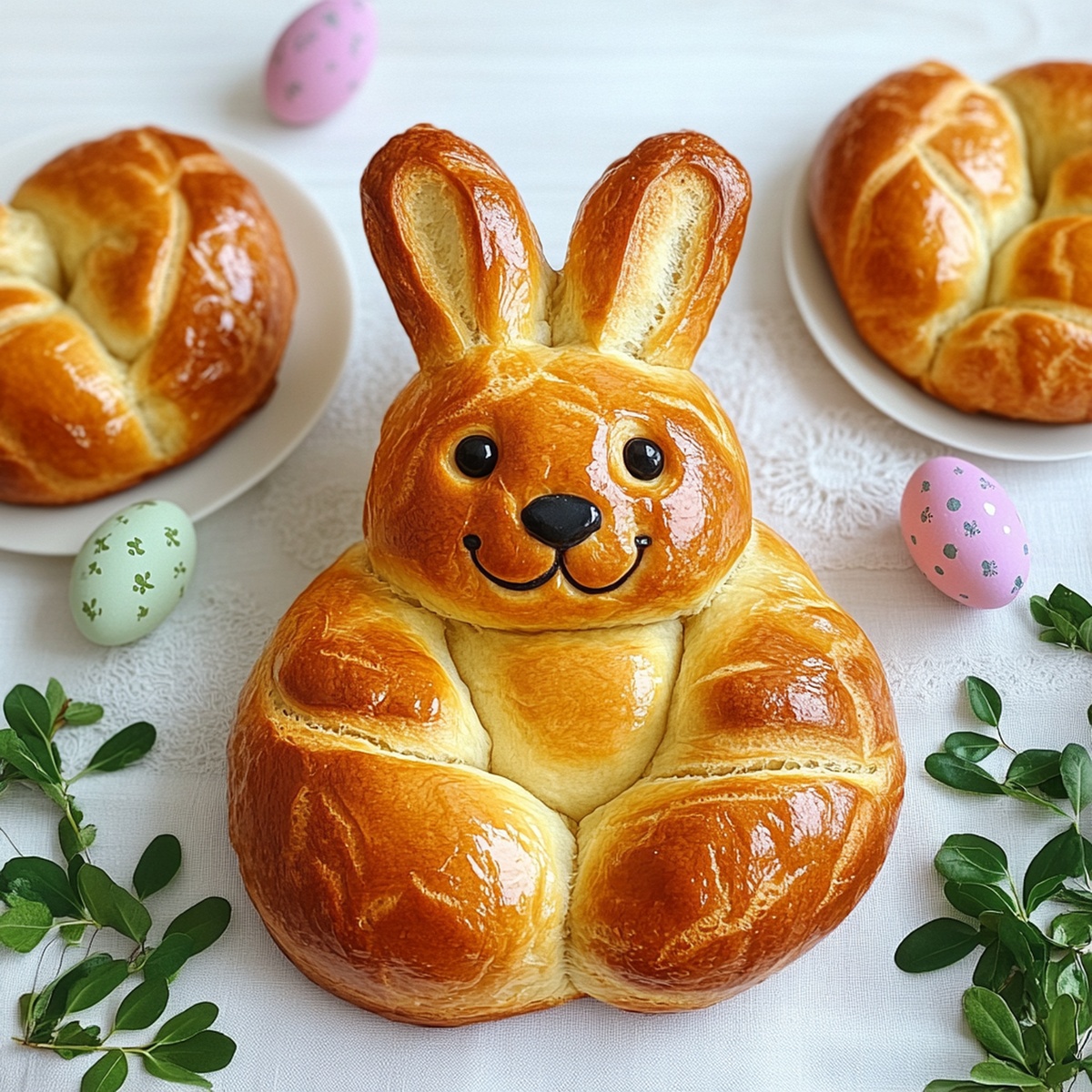Greek Easter Bunny Bread Recipe That’s Fun to Shape and Bake
Tucked away in traditional greek easter bunny bread lies a delightful culinary surprise that captures childhood memories.
Soft, pillowy dough winds into playful rabbit shapes, each curve telling a story of festive celebration.
Generations have passed down this cherished recipe, whispering secrets of tender texture and cultural significance.
Intricate braiding techniques transform simple ingredients into edible art that sparks joy and connection.
Bakers of all skill levels can embrace this delectable tradition with confidence and creativity.
Neighbors and relatives will marvel at your handcrafted masterpiece, eager to taste its warm, sweet essence.
Let this bread become your gateway to experiencing the rich tapestry of greek Easter traditions.
Why Greek Easter Bunny Bread Is Soft, Sweet, And Festive
What Goes Into Greek Easter Bunny Bread
Bread Base Ingredients:Liquid and Fat Ingredients:Flavor and Aromatic Ingredients:Decoration and Finishing Ingredients:How To Shape Greek Easter Bunny Bread With Ease
Step 1: Awaken The Yeast
Grab some warm water and sprinkle in yeast with a pinch of sugar. Let the mixture bubble and dance for about 10 minutes until it looks frothy and alive.
Step 2: Mix Magical Dough Ingredients
Gather your dry ingredients in a large mixing bowl:In another bowl, whisk together:Pour the yeast mixture into the wet ingredients and combine with dry ingredients until a soft, pillowy dough emerges.
Step 3: Knead And Nurture The Dough
Transfer the dough to a lightly floured surface. Knead with loving energy for 5-7 minutes until smooth and springy. Place the dough in a greased bowl, cover with a damp cloth, and let it rise in a cozy spot for about 1.5 hours.
Step 4: Sculpt Your Bunny
Punch down the dough and create bunny body parts:Step 5: Bring Bunny To Life
Arrange the dough pieces on a parchment-lined baking sheet, forming a cute bunny shape. Use raisins for eyes and sliced almonds for adorable teeth.
Step 6: Final Rise And Prep
Cover the bunny with a clean towel and let it rest for 30 minutes. Preheat the oven to 350F.
Step 7: Golden Glaze
Whisk an egg with water and gently brush over the dough to create a beautiful golden sheen.
Step 8: Bake To Perfection
Slide the bunny into the oven and bake for 25-30 minutes. The bread is ready when it turns golden brown and sounds hollow when tapped.
Enjoy your adorable edible bunny creation!
Tips To Make Greek Easter Bunny Bread Fluffy And Golden
How To Store Greek Easter Bunny Bread Properly
Perfect Pairings For Greek Easter Bunny Bread
Ways To Decorate Greek Easter Bunny Bread
Greek Easter Bunny Bread FAQs
This bread is a traditional Greek Easter treat that symbolizes new life and resurrection. It’s not just bread, but a festive art form where you create a cute bunny shape using dough, making it a delightful centerpiece for family celebrations.
Absolutely! The anise seeds are optional. If you’re not a fan of their licorice-like flavor, simply omit them without affecting the bread’s overall texture or structure.
While it might seem intimidating, shaping the bunny is quite manageable. Just take your time, follow the step-by-step instructions, and don’t worry about making it perfect. The charm is in its handmade, rustic appearance.
This bread is slightly sweet, with a delicate hint of orange zest and vanilla. It’s more of a soft, enriched bread that’s perfect for a festive breakfast or as a special Easter treat.
Print
Greek Easter Bunny Bread Recipe
- Total Time: 3 hours
- Yield: 12 1x
Description
Spice up your Easter celebration with this aromatic Greek Easter Bunny Bread, a festive treat steeped in traditional Greek culinary artistry. Sweet, braided dough shaped like a charming bunny brings cultural charm to your holiday table, delighting family and friends with its delectable flavor and whimsical design.
Ingredients
Main Ingredients:
- 5 ½ cups all-purpose flour (plus more for dusting)
- 2 large eggs
- 1 cup milk
- 5 tablespoons unsalted butter, melted
- ½ cup sugar
Liquid and Flavor Enhancers:
- ⅓ cup warm water (110°F / 43°C)
- 2 ¼ teaspoons active dry yeast (1 packet)
- 1 teaspoon vanilla extract
- 1 tablespoon grated orange zest
- 1 teaspoon anise seeds (optional)
- 1 teaspoon salt
Decorative and Finishing Ingredients:
- 1 egg (for egg wash)
- Raisins or currants (for eyes)
- Sliced almonds (for teeth)
- Cooking spray or oil (for greasing)
Instructions
- Prepare the yeast activation mixture by gently dissolving yeast with a portion of sugar in warm water, allowing it to develop a frothy texture over 5-10 minutes.
- Create a comprehensive mixing base by combining dry ingredients including remaining sugar, flour, salt, orange zest, and anise seeds in a spacious mixing vessel.
- Separately whisk together liquid components: milk, melted butter, eggs, and vanilla extract, then integrate the activated yeast mixture.
- Merge wet and dry ingredients, stirring carefully until a cohesive, soft dough emerges.
- Transfer the dough onto a lightly floured surface and knead methodically for 5-7 minutes, developing a smooth and elastic consistency.
- Place the kneaded dough into a greased bowl, drape with a damp cloth, and allow it to proof in a warm environment until its volume doubles.
- Gently deflate the risen dough and meticulously craft the bunny shape using varied dough pieces: forming an oval body, rounded head, looped ears, small cheek balls, diminutive nose, and a flattened tail.
- Artfully arrange the dough pieces on a parchment-lined baking sheet, creating a bunny silhouette.
- Embellish the bunny with raisin eyes and sliced almond teeth for character.
- Cover the shaped dough with a clean towel and permit a secondary rise for approximately 30 minutes.
- Heat the oven to 350F (175C) while preparing an egg wash by whisking an egg with water.
- Delicately brush the egg wash over the formed bunny to ensure a lustrous, golden exterior.
- Bake until the bread achieves a rich golden-brown color and produces a hollow sound when gently tapped, approximately 25-30 minutes.
Notes
- Swap anise seeds with other warming spices like cinnamon or cardamom for varied flavor profiles if traditional taste isn’t preferred.
- Ensure water temperature for yeast activation stays between 100-110°F to prevent killing the active cultures, which can lead to dense bread.
- Use room temperature ingredients to help dough rise evenly and create consistent texture throughout the bunny-shaped bread.
- Consider making the dough ahead and refrigerating overnight for deeper flavor development and more convenient preparation.
- Prep Time: 30 minutes
- Cook Time: 30 minutes
- Category: Breakfast, Snacks, Desserts
- Method: Baking
- Cuisine: Greek
Nutrition
- Serving Size: 12
- Calories: 205
- Sugar: 9 g
- Sodium: 200 mg
- Fat: 6 g
- Saturated Fat: 3 g
- Unsaturated Fat: 2 g
- Trans Fat: 0 g
- Carbohydrates: 30 g
- Fiber: 1 g
- Protein: 5 g
- Cholesterol: 50 mg




Emily Morgan
Food Critic & Kitchen Tips Specialist
Expertise
Global Food Exploration & Critique, Simple Kitchen Hacks & Time-Saving Tips, Presentation & Plating Techniques, Culinary Research & Storytelling.
Education
New York University
Emily Morgan has journeyed across the globe, collecting culinary secrets that turn everyday ingredients into impressive meals.
Based in Seattle and armed with a Journalism degree from NYU, she blends thorough research with a flair for presentation, ensuring every dish looks just as good as it tastes.
Focusing on fresh flavors, simple methods, and a bit of fun, Emily shows home cooks how to elevate their daily cooking without fancy gadgets or complex steps.